Selecting a wood-burning stove for your log siding home is a critical decision.
Table of Contents
Selecting a wood-burning stove for your log siding home is a critical decision. Think of wood stoves as space heaters that are good for heating one zone of your home. If you have a basement or second floor, you may want another stove for that level.
Many log homeowners think they need a huge stove to adequately heat the great room and kitchen areas in really cold weather. If you have high R-value insulation and efficient windows, huge stoves may be an overkill. Use the following ideas to select the best stove options for efficient heat, ease of use, and low maintenance.
Size Does Makes a Difference
Heating experts provide some guidelines for selecting the right size stove for log homes. Follow these ideas for heating with one stove based on its heating capacity for a full load of wood:
- Small Size Stove – Will heat an area up to 500 square feet
- Medium Size Stove – Will heat an area between 500 – 1,000 square feet
- Large Size Stove – Will heat an area between 1,000 – 2,000 square feet
The larger the wood box, the less often you need to add more firewood. Check with your stove dealer to also determine the size wood box needed to produce the desired amount of BTUs
Types of Wood-Burning Stoves
Do you want to use your stove for heating only or heating, cooking, and boiling water? The answer lies in either a utility, decorative, or combination of both stove. In this article, stove means a free-standing unit that is at least 70% efficient.
The three major types of wood stoves common in the U.S. include:
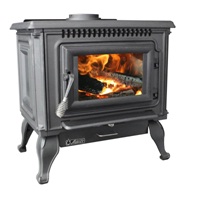
- Circulating
- Radiant
- Combustion
Circulating models are the most heat-efficient because they are double-walled with an inner combustion chamber. The outer sheet metal shell helps the airflow generate more heat and also has a draft control.
Radiant models such as pot-bellied or similar stoves have an enclosed firebox that can turn out a lot of heat. They usually have a cook-top for heating water or cooking food. Franklin stoves, aka combustion models, have a U-shaped flue that draws hot gases from the fire into a hollow baffle. This arrangement heats the cool air inside the baffle and sends it out in the room through vents close to the top.
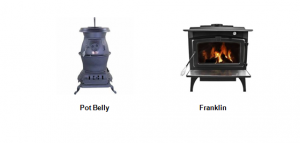 Carefully consider the size of the available space and the location of your stove for maximum heating potential and aesthetics. Discover more details about catalytic and non-catalytic stoves, pipes, and chimneys from
Carefully consider the size of the available space and the location of your stove for maximum heating potential and aesthetics. Discover more details about catalytic and non-catalytic stoves, pipes, and chimneys from
Grit Rural American.
“Many log homeowners think they need a huge stove to adequately heat the great room and kitchen areas in really cold weather. If you have high R-value insulation and efficient windows, huge stoves may be an overkill.”
Our best advice is use the highest quality stove pipes you can afford. Install double-wall or triple- wall where needed for safer operation. When installed properly, your stove should produce the desired results; when poorly installed, even the best wood units will give poor results.
Installation of Stoves and Pipes
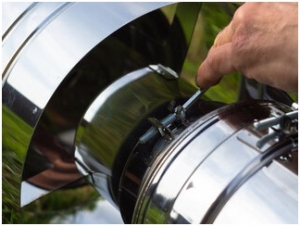
You will get the best installation by letting a chimney sweep certified by the Chimney Safety Institute of America (CSIA) do the job. All stove components must conform to building and insurance codes and regulations.
Talk to your stove professional about the best type of material that should go under and behind the stove in your circumstances. It’s better to be safe than sorry because some DIY installers have set their log homes on fire. Using a blower or fan will help circulate the air much better. Watch this great stove installation video for a better understanding of the process.
Best Wood Varieties to Burn
You may not have the highest BTU producing wood in your area or you may not be able to afford to burn a lot of it. The best and worst woods for producing a lot of heat are:
Best Choices Worst Choices
Oak and Hickory Pine and Fir
Maple and Ash Cypress and Spruce
Hawthorn and Beech Cedar and Poplar
Sycamore and Cherry Eucalyptus and Alder
Locust and Birch
The ‘worst’ woods will burn too quickly or have too much sap that produces dangerous creosote. An effective wood burning stove and quality wood provide these benefits:

- Less sawing, splitting, and chopping
- Less carrying to the woodpile and stacking
- Least expense for stove operation
- Fewer trips to the woodpile to refuel
Talk to your wood stove dealer, installer, or wood supplier if you are not familiar with wood varieties in your area.
Care of Your Stove and Pipes
Take care of both the inside and outside of your stove for effective heating and long life. Take out the ashes as needed, replace any damaged fire bricks, and occasionally check for any air leaks around the door. Clean the top of your stove with stove black to keep it looking fresh.
HINT: Burning too much green wood will cause a creosote buildup in your stove and especially in the pipes. Mix two or three seasoned logs with each green log to keep the buildup at a minimum. You must swab out the pipes with a tight-fitting brush to effectively clean them. If you don’t feel comfortable getting on the roof and doing this yourself, hire a chimney sweep.
Wood-burning stoves produce dry air that is hard on the bronchial tubes and the woodwork. Overcome this by placing a container such as a tea kettle or large pot filled with water. The evaporating water will raise the humidity level for a healthier home (35%-50%).
(Your woodstove will look more rustic sitting on a beautiful knotty pine floor.)
References and Resources:
Selecting a wood-burning stove for your log siding home is a critical decision.

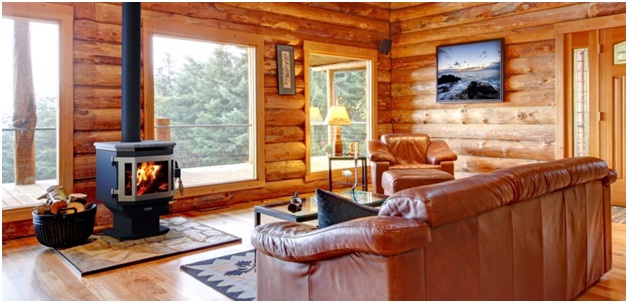
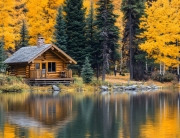
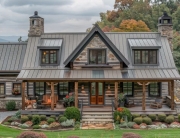
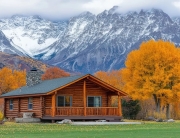
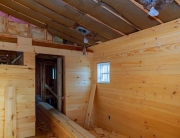
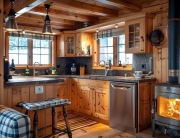
Recent Comments